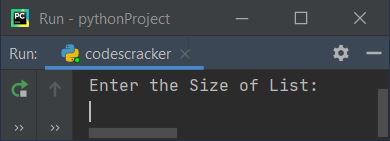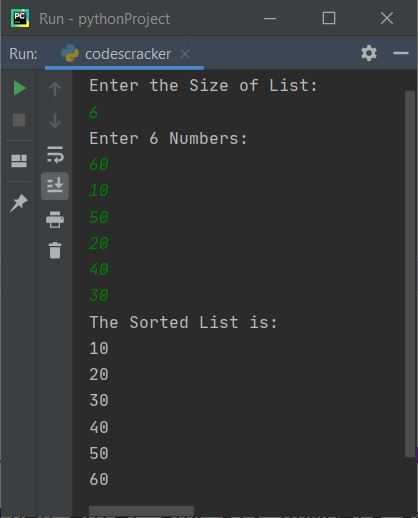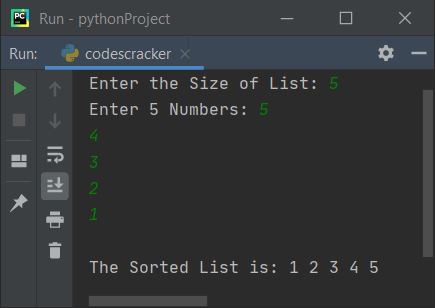- Python Basic Programs
- Python Program Examples
- Python Print Hello World
- Python Get Input from User
- Python Add Two Numbers
- Add Subtract Multiply Divide
- Python Check Even or Odd
- Python Check Prime or Not
- Python Check Alphabet or Not
- Python Check Vowel or Not
- Python Check Leap Year or Not
- Check Reverse equal Original
- Check Positive Negative Zero
- Python Check Armstrong or Not
- Python Check Palindrome or Not
- Python Check Perfect Number
- Python Find Reverse of Number
- Python Count Digits in Number
- Python Add Digits of Number
- Sum of First and Last Digits
- Python Product of Mid Digits
- Sum of Squares of Digits
- Interchange Digits of Number
- Python Sum of n Numbers
- Python Print ASCII Values
- Python Swap Two Numbers
- Python Swap Two Variables
- Python Fahrenheit to Celsius
- Python Celsius to Fahrenheit
- Python Display Calendar
- Python Days into Years, Weeks
- Find Largest of Two Number
- Find Largest of Three Number
- Python Print Fibonacci Series
- Generate Armstrong Numbers
- Python Make Simple Calculator
- Python Add Binary Numbers
- Binary Number Multiplication
- Python Mathematical Programs
- Find Sum of Natural Numbers
- Find Average of n Numbers
- Python Print Multiplication Table
- Print Table using Recursion
- Python Find Average Percentage
- Python Find Grade of Student
- Find Square Root of Number
- Python Print Prime Numbers
- Find Numbers Divisible by
- Python Find Factors of Number
- Python Find Factorial of a Number
- Python Find HCF & LCM
- Python Kilometres to Miles
- Python Find Area of Square
- Python Find Area of Rectangle
- Python Find Area of Triangle
- Python Find Area of Circle
- Python Find Perimeter of Square
- Find Perimeter of Rectangle
- Python Find Perimeter of Triangle
- Find Circumference of Circle
- Python Simple Interest
- Python Solve Quadratic Equation
- Python Different Set of Operations
- Python Display Powers of 2
- Python Find nCr & nPr
- Python Pattern Programs
- Python Print Pattern Programs
- Python Print Diamond Pattern
- Python Print Floyd's Triangle
- Python Print Pascal's Triangle
- Python List Programs
- Python Count Even/Odd in List
- Python Positive/Negative in List
- Python Even Numbers in List
- Python Odd Numbers in List
- Python Sum of Elements in List
- Sum of Odd/Even Numbers
- Python Element at Even Position
- Python Element at Odd Position
- Python Search Element in List
- Python Largest Number in List
- Python Smallest Number in List
- Python Second Largest in List
- Python Second Smallest in List
- Python Insert Element in List
- Python Delete Element from List
- Python Multiply Numbers in List
- Swap Two Elements in List
- Python 1D Array Program
- Python Linear Search
- Python Binary Search
- Python Insertion Sort
- Python Bubble Sort
- Python Selection Sort
- Remove Duplicates from List
- Python Reverse a List
- Python Merge Two List
- Python Copy a List
- Python Conversion Programs
- Python Decimal to Binary
- Python Decimal to Octal
- Python Decimal to Hexadecimal
- Python Binary to Decimal
- Python Binary to Octal
- Python Binary to Hexadecimal
- Python Octal to Decimal
- Python Octal to Binary
- Python Octal to Hexadecimal
- Python Hexadecimal to Decimal
- Python Hexadecimal to Binary
- Python Hexadecimal to Octal
- Python Matrix Programs
- Python Add Two Matrices
- Python Subtract Two Matrices
- Python Transpose Matrix
- Python Multiply Matrices
- Python String Programs
- Python Print String
- Python Find Length of String
- Python Compare Two Strings
- Python Copy String
- Python Concatenate String
- Python Reverse a String
- Python Swap Two Strings
- Python Uppercase to Lowercase
- Python Lowercase to Uppercase
- Python Check Substring in String
- Python Count Character in String
- Count Repeated Characters
- Python Count Word in Sentence
- Python Count Each Vowels
- Python Capitalize Character
- Python Capitalize Word in String
- Python Smallest/Largest Word
- Remove Spaces from String
- Remove Duplicate Character
- Remove Vowels from String
- Remove Punctuation from String
- Python Remove Word in String
- Python Remove Duplicate Words
- WhiteSpace to Hyphens
- Replace Vowels with Character
- Replace Character in String
- Python Sort String in Alphabetical
- Sort Word in Alphabetical Order
- Extract Number from String
- Python Check Anagram Strings
- Python File Programs
- Python Read a File
- Python Write to File
- Python Append Text to File
- Python Copy Files
- Python Merge Two Files
- Python Counts Characters in File
- Python Count Words in File
- Python File Content in Reverse
- Python Lines Contains String
- Python Delete Line from File
- Python Capitalize Word in File
- Python Replace Text in File
- Replace Specific Line in File
- Python Find Size of File
- Python List Files in Directory
- Python Delete Files
- Python Misc Programs
- Python Reverse a Tuple
- Python Merge Two Dictionary
- Python bytes to String
- Python bytearray to String
- Generate Random Numbers
- Python Print Address of Variable
- Python Print Date and Time
- Python Get IP Address
- Python Shutdown/Restart PC
- Python Tutorial
- Python Tutorial
Bubble Sort Program in Python
In this article, you will learn and get code on bubble sort in Python. But before going through the program on bubble sort, if you're not aware about logic used behind it, refer to Bubble Sort Logic and Example to understand about the topic.
Bubble Sort using List
This program sorts a list using bubble sort technique. The question is, write a program in Python to apply bubble sort technique to sort a list. The answer to this question is given below:
nums = [] print("Enter the Size of List: ") tot = int(input()) print("Enter " + str(tot) + " Numbers: ") for i in range(tot): nums.insert(i, int(input())) for i in range(tot-1): for j in range(tot-i-1): if nums[j]>nums[j+1]: temp = nums[j] nums[j] = nums[j+1] nums[j+1] = temp print("The Sorted List is:") for i in range(tot): print(nums[i])
Here is its sample run:

Now supply the size of list say 6 and then enter any six numbers say 60, 10, 50, 20, 40, 30, press
ENTER key to sort the list using bubble sort technique as shown in the sample run given below:

Note - The str() method is used to convert an int type value to string type.
Note - The range() returns a sequence of values. The value starts with 0 and increments by 1, by default. It stops before a number specified as its argument. For example, the following block of code:
for i in range(3): print(i)
prints 0 1 2 on output. The total execution of print(i) statement is exactly three times (the value given as argument of range()). Each number gets printed in new line. Therefore from above program, the following statement:
for i in range(tot-1):
is used to executed the following block of code:
for j in range(tot-i-1): if nums[j]>nums[j+1]: temp = nums[j] nums[j] = nums[j+1] nums[j+1] = temp
(tot-i-1) number of times. In similar way the second for loop (the inner one) is used.
Since in bubble sort, each adjacent element gets compared and swapped, if required. Therefore with this block of code, we've applied the bubble sort technique to sort the given list of numbers.
Modified Version of Previous Program
This is the modified version of previous program. The only thing added in this program is end, to output the thing in Python. Since print() outputs the thing present inside its braces terminated with an automatic newline. Therefore we've used end to end the thing with exactly given in its braces.
nums = [] print(end="Enter the Size of List: ") tot = int(input()) print(end="Enter " + str(tot) + " Numbers: ") for i in range(tot): nums.insert(i, int(input())) for i in range(tot-1): for j in range(tot-i-1): if nums[j]>nums[j+1]: temp = nums[j] nums[j] = nums[j+1] nums[j+1] = temp print(end="\nThe Sorted List is: ") for i in range(tot): print(end=str(nums[i]) + " ") print()
Here is its sample run with user input 5 as size, and 5, 4, 3, 2, 1 as five numbers:

« Previous Program Next Program »